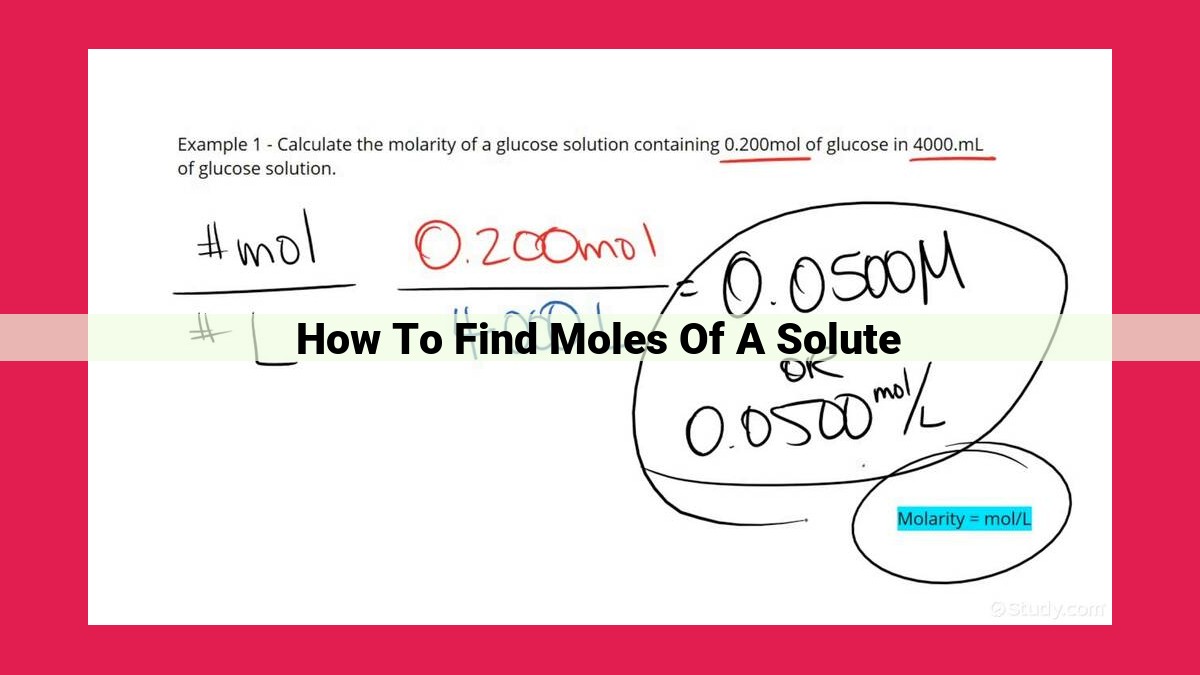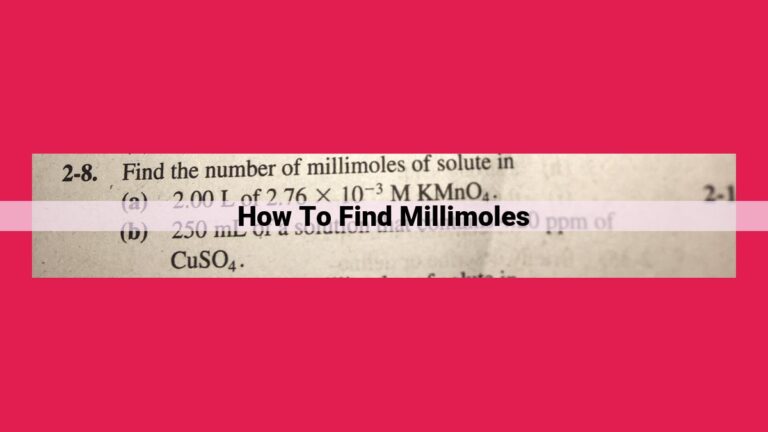Mastering Mole Calculations: A Comprehensive Guide To Molarity And Stoichiometry For Chemical Applications

Finding moles of a solute involves understanding concentration, specifically molarity (M), which represents moles per liter of solution. To calculate moles, multiply concentration by volume (moles = M * L). Molecular weight (sum of atomic weights) connects mass and moles (moles = mass / molecular weight). Stoichiometry and volume play crucial roles in chemical calculations. The key steps to find moles of a solute are: determine concentration, measure volume, and apply the formula moles = concentration * volume. This information is vital for various chemical applications, such as determining reactant quantities and predicting product yields.
Unveiling the Significance of Solute Moles in Chemical Applications
In the intricate world of chemistry, the ability to accurately determine the moles of a solute is crucial for unlocking a myriad of important applications. From deciphering the concentrations of solutions to predicting reaction yields, understanding moles plays a vital role in unraveling the secrets of chemical phenomena.
Navigating the Maze of Chemical Concentration
Concentration, the measure of the amount of solute dissolved in a specific volume of solution, is a fundamental concept in chemistry. Molarity (M), a unit of concentration, expresses the number of moles of solute per liter of solution. This relationship between moles and volume opens the door to a deeper understanding of chemical reactions and their outcomes.
Defining Molarity: The Essence of Quantifying Solutions
Molarity, represented by the symbol M, serves as a numerical representation of the concentration of a solution. It signifies the precise number of moles of solute present in one liter of the solution. This quantitative measure empowers chemists to determine the amount of solute in a specific volume, enabling them to manipulate solutions and reactions with greater precision.
Introducing the Mole: The Cornerstone of Chemical Quantities
The mole, a fundamental unit of measurement in chemistry, represents a specific amount of substance. It embodies a staggering 6.022 × 10^23 entities, whether atoms, molecules, ions, or electrons. This numerical value, known as Avogadro’s number, provides a common ground for quantifying microscopic entities and macroscopic quantities.
Deciphering Molecular Weight: Unraveling the Mass of Molecules
Molecular weight, the sum of the atomic weights of all atoms in a molecule, serves as a fingerprint for each compound. It represents the mass of one mole of a substance and enables chemists to convert between mass and moles. This understanding unlocks the ability to determine the precise amount of solute present in a given sample.
Mass and Moles: Unveiling the Interplay of Matter
Mass, a measure of the amount of matter in an object, bears a direct relationship to moles. The formula moles = mass / molecular weight establishes a bridge between these two fundamental quantities. This equation allows for the conversion between mass and moles, empowering chemists to quantify substances accurately.
Stoichiometry: Unveiling the Secrets of Chemical Reactions
Stoichiometry, the study of quantitative relationships in chemical reactions, hinges on understanding moles. It enables chemists to predict the reactant and product quantities involved in a reaction, ensuring optimal outcomes. By deciphering these stoichiometric ratios, chemists can optimize reactions, minimize waste, and maximize efficiency.
Understanding Concentration: A Journey into the Heart of Chemical Solutions
In the realm of chemistry, understanding concentration is like deciphering the blueprint of a solution. It allows us to unravel the hidden relationships between the moles of solute (the dissolved substance) and the volume of solution.
Concentration is the measure of how much solute is packed into a specific volume of solution. The most common unit of concentration is molarity (M), which represents the number of moles of solute per liter of solution.
Consider a scenario: You have a beaker of water with a teaspoon of salt dissolved in it. The moles of solute represent the actual amount of salt present, while the volume of solution is the total space occupied by the water and salt combined.
The relationship between moles of solute and volume of solution is like a delicate balancing act. As you add more salt to the water, the concentration (molarity) increases because you’re packing more moles of solute into the same volume. Conversely, if you add more water to the solution without adding more salt, the concentration decreases because the moles of solute are now spread over a larger volume.
Understanding concentration is crucial for various chemical applications. It helps us:
- Predict the properties of solutions: High concentrations can affect the physical and chemical properties of solutions, such as their freezing point, boiling point, and reactivity.
- Perform quantitative analysis: By determining the concentration of a solution, we can calculate the amount of solute present in a sample.
- Design experiments and reactions: Knowing the concentration allows us to control the stoichiometry of reactions, ensuring that the reactants are present in the correct proportions.
So, next time you’re faced with a chemical solution, remember that concentration is the key to unlocking its secrets. It’s the gateway to understanding its properties and behavior.
Defining Molarity
- Introduce the concept of molarity as the number of moles of solute per liter of solution.
- Provide the formula for calculating molarity: M = moles / volume (L).
Defining Molarity: A Cornerstone of Chemical Calculations
In the vast realm of chemistry, understanding the concentration of solutions is paramount for countless applications, from analytical chemistry to industrial processes. At the heart of this understanding lies the concept of molarity, an invaluable tool for expressing the amount of a solute dissolved in a specific volume of solution.
Introducing Molarity
Molarity, denoted by the symbol M, is a measure of concentration that quantifies the moles of solute dissolved in one liter of solution. It serves as a benchmark for comparing the relative amounts of different solutes in various solutions.
Calculating Molarity: A Simple Formula
Determining molarity is a straightforward process. The formula, M = moles / volume (L), provides a clear path to calculating this crucial parameter. By dividing the number of moles of solute by the volume of the solution in liters, we obtain the molarity of the solution.
Molarity in Action: A Practical Example
Consider a solution containing 0.2 moles of sodium chloride (NaCl) dissolved in 500 milliliters (0.5 liters) of water. To calculate the molarity of this solution, we simply divide 0.2 moles by 0.5 liters, yielding a molarity of 0.4 M. This value indicates that for every liter of this solution, 0.4 moles of NaCl are present.
Molarity: A Bridge between Mass and Volume
Molarity serves as an essential bridge between the mass and volume of a solution. By knowing the mass of the solute and the volume of the solution, we can utilize the formula moles = mass / molecular weight, where molecular weight represents the sum of the atomic weights of the elements in the solute, to determine the number of moles of solute. Once the moles are known, molarity can be readily calculated.
Molarity remains a cornerstone of chemical calculations, providing a standardized and convenient way to express the concentration of solutions. Its versatility extends across diverse scientific disciplines, enabling researchers, students, and practitioners to accurately quantify and manipulate solutes for a wide range of purposes.
Moles: The Cornerstone of Chemical Calculations
In the fascinating realm of chemistry, understanding the concept of moles is crucial for unraveling the mysteries of chemical reactions and quantitative analysis. A mole represents a specific amount of substance, a staggering 6.022 × 10^23 entities, be it atoms, molecules, ions, or electrons.
Now, let’s establish a vital connection between moles and mass. The molecular weight of a substance, calculated as the sum of atomic weights of its constituent atoms, plays a key role in this relationship. Just as a penny’s value is determined by its weight, so too is the mass of a specific number of entities related to their molecular weight.
To convert mass to moles, we employ a simple yet powerful formula: moles = mass / molecular weight. This formula opens the door to understanding the hidden treasures within chemical substances. For instance, knowing the mass of a compound and its molecular weight, we can unlock the secrets of its composition and delve into the depths of its chemical behavior.
Calculating Molecular Weight
- Define molecular weight as the sum of atomic weights of atoms in a molecule.
- Provide steps for calculating molecular weight from a chemical formula.
How to Calculate Molecular Weight: A Comprehensive Guide
In chemistry, understanding the molecular weight of a compound is crucial for various calculations and applications. Molecular weight is the sum of the atomic weights of all the atoms that make up a molecule. To determine the molecular weight, you need to know the chemical formula of the compound. Here’s a step-by-step guide to help you calculate molecular weight:
Step 1: Identify the Chemical Formula
The chemical formula of a compound tells you what elements are present and in what proportion. For example, the chemical formula for water is H₂O, which means it contains two hydrogen atoms and one oxygen atom.
Step 2: Look Up Atomic Weights
Each element has a specific atomic weight, which is the average mass of all the naturally occurring isotopes of that element. You can find the atomic weights of elements in the Periodic Table. For hydrogen, the atomic weight is 1.008, and for oxygen, it’s 16.00.
Step 3: Multiply Atomic Weights by the Number of Atoms
In the chemical formula, each element’s symbol is followed by a subscript that indicates the number of atoms of that element present. For each element in the formula, multiply its atomic weight by the number of atoms present. For H₂O, you would multiply 1.008 by 2 and 16.00 by 1.
Step 4: Add Up the Products
Once you have multiplied the atomic weights by the number of atoms for each element, add these products together to get the molecular weight of the compound. For H₂O, the calculation would be: (1.008 x 2) + (16.00 x 1) = 18.016.
Therefore, the molecular weight of water is 18.016 grams per mole.
Significance of Molecular Weight
Knowing the molecular weight of a compound is essential for:
- Determining the molar mass, which is the mass of one mole of a substance
- Calculating the concentration of solutions, such as molarity
- Stoichiometric calculations in chemical reactions, which involve determining the relative amounts of reactants and products
Understanding Mass and Its Relationship to Moles
In the realm of chemistry, understanding the concept of moles is crucial for deciphering the quantitative relationships between substances involved in chemical reactions. One of the key aspects in this understanding is the relationship between mass and moles.
Mass is a fundamental property of matter, representing the amount of substance present in a given sample. It is often measured in grams. Moles, on the other hand, represent the amount of substance in terms of the number of elementary entities (atoms, molecules, or ions) present. One mole is defined as the amount of substance that contains exactly 6.022 × 10^23 elementary entities.
The connection between mass and moles is established through the concept of molecular weight. Molecular weight is the sum of the atomic weights of all the atoms in a molecule. By knowing the molecular weight of a substance, we can convert its mass into moles using the following formula:
moles = mass / molecular weight
For instance, if we have a sample of 100 grams of glucose (C6H12O6), we can calculate the number of moles present:
- Molecular weight of glucose = 180 g/mol
- moles of glucose = 100 g / 180 g/mol = 0.56 moles
This conversion is vital in stoichiometric calculations, where we determine the quantitative relationships between reactants and products in a chemical reaction. By knowing the moles of reactants and products, we can predict the product yields and optimize reaction conditions accordingly.
Stoichiometry and Its Role in Chemistry
- Explain the concept of stoichiometry and its use in determining quantitative relationships in chemical reactions.
- Highlight the importance of stoichiometry in predicting product yields.
Stoichiometry: Unraveling the Secrets of Chemical Reactions
In the realm of chemistry, stoichiometry emerges as a guiding light, illuminating the quantitative relationships that orchestrate chemical transformations. This concept empowers us to decipher the interplay between reactants and products, enabling us to predict the yields of our experiments and optimize our synthetic pathways.
Stoichiometry, derived from the Greek words “stoicheion” (element) and “metron” (measure), provides a systematic framework for understanding the proportions of reactants and products involved in a chemical reaction. By delving into the balanced chemical equation that represents a reaction, we can uncover the exact numerical ratios between the reactants and products. These ratios, expressed in terms of moles, serve as the foundation for stoichiometric calculations.
Armed with this knowledge, we can embark on a journey to unravel the mysteries of chemical reactions. We can determine the limiting reactant, which dictates the maximum amount of product that can be formed, and calculate the theoretical yield of the reaction. Furthermore, stoichiometry allows us to balance chemical equations, ensuring that the number of atoms of each element remains constant throughout the reaction, a principle enshrined in the law of conservation of mass.
In essence, stoichiometry empowers us to navigate the intricate tapestry of chemical reactions, unlocking the secrets of their quantitative relationships. It allows us to predict outcomes, optimize experiments, and gain a deeper understanding of the molecular world around us. As you delve into the depths of stoichiometry, you will discover a powerful tool that will illuminate your path as you explore the fascinating realm of chemistry.
Volume and its Importance in Calculations
- Define volume as the amount of space occupied by a substance.
- Provide the units of volume and explain its relationship to moles through concentration.
Volume: A Crucial Factor in Chemical Calculations
In the realm of chemistry, the understanding of volume plays a pivotal role in numerous calculations and applications. Volume refers to the amount of space occupied by a substance. The units of volume commonly used in chemistry include liters (L), milliliters (mL), and cubic centimeters (cm³).
The relationship between volume and moles is intricately linked through the concept of concentration. Concentration, represented by the symbol M (molarity), refers to the number of moles of solute (the substance being dissolved) present in one liter of solution. The formula for calculating molarity is:
Molarity (M) = Moles of Solute / Volume of Solution (L)
This formula highlights that as the number of moles of solute increases, the concentration increases. Conversely, as the volume of the solution increases, the concentration decreases.
Comprehending the relationship between volume and moles is essential in stoichiometry, the branch of chemistry that deals with quantitative relationships in chemical reactions. By utilizing stoichiometry, scientists can predict the amounts of reactants and products involved in a reaction. It also enables researchers to determine the limiting reactant, which is the substance that is completely consumed in a reaction, thereby limiting the amount of product that can be formed.
In summary, volume is a crucial factor in chemical calculations. Its relationship with moles through concentration allows scientists to determine the amount of solute present in a solution and predict the outcomes of chemical reactions. By understanding the interplay between volume and moles, chemists can delve deeper into the intricacies of chemical transformations and make accurate predictions in their experiments.
Steps to Find Moles of a Solute
- List the steps involved in finding the moles of a solute:
- Determining concentration (M)
- Measuring or determining volume (L)
- Calculating moles using the formula: moles = concentration (M) * volume (L)
Determining the Moles of a Solute: A Comprehensive Guide
In chemistry, understanding the amount of solute in a solution is crucial for performing various calculations and predicting the outcomes of chemical reactions. This is where the concept of moles comes into play.
What is Concentration?
- Concentration measures the amount of solute dissolved in a given volume of solution.
- Molarity (M) is a common unit of concentration, defined as the number of moles of solute per liter of solution.
Defining Molarity and the Mole
- Molarity is calculated using the formula: M = moles / volume (L)
- A mole is a specific amount of substance, defined as 6.022 × 10^23 entities (atoms, molecules, etc.).
Calculating Molecular Weight
- Molecular weight is the sum of the atomic weights of the atoms in a molecule.
- It helps convert mass to moles using the formula: moles = mass / molecular weight
Stoichiometry and Chemical Reactions
- Stoichiometry helps determine quantitative relationships in chemical reactions.
- It predicts the product yields based on the starting amounts of reactants.
Volume and its Importance
- Volume indicates the amount of space occupied by a substance.
- In chemistry, volume is often expressed in liters and is related to moles through concentration.
Steps to Find Moles of a Solute
- Determine concentration (M): Measure the concentration of the solution in moles per liter.
- Measure or determine volume (L): Accurately measure or calculate the volume of the solution in liters.
- Calculate moles: Use the formula moles = concentration (M) * volume (L) to find the moles of solute.
By understanding these concepts and following the steps outlined above, you can accurately determine the moles of a solute in a given solution. This knowledge is essential for various chemical calculations and applications, allowing you to confidently navigate the world of chemistry.


